January 5, 2016 — Oak Ridge National Laboratory experts are playing leading roles in the recently established Department of Energy’s (DOE’s) Exascale Computing Project (ECP), a multi-lab initiative responsible for developing the strategy, aligning the resources, and conducting the R&D necessary to achieve the nation’s imperative of delivering exascale computing by 2021.
ECP’s mission is to ensure all the necessary pieces are in place for the first exascale systems – an ecosystem that includes applications, software stack, architecture, advanced system engineering and hardware components – to enable fully functional, capable exascale computing environments critical to scientific discovery, national security, and a strong U.S. economy.
In September ECP announced the first round of funding for application development, totaling $34.8 million, and named 15 key research projects along with a group of seven “seed” level projects.
Doug Kothe, deputy associate lab director of ORNL’s Computing and Computational Sciences Directorate and Applications Development director for ECP, sees his focus area as a key component for preparing researchers to make the most of exascale computers as soon as they are deployed.
“The mission of the ECP application development focus area is to deliver science-based applications able to exploit exascale for high-confidence insights and answers to problems of national importance,” he said. “The scope of this project encompasses U.S. strategic pillars such as national security, energy assurance, economic competitiveness, and health enhancement.
These ECP projects will create and enhance applications through development of models, algorithms, and methods; integration of software and hardware using co-design methodologies; improvement of exascale system readiness and utilization; and demonstration of exascale challenge problem capabilities.”
ORNL leads three and participates in nine of the 22 Application Development projects.
Paul Kent, a senior researcher at the laboratory, is the principal investigator of “QMCPACK: A Framework for Predictive and Systematically Improvable Quantum-Mechanics-Based Simulations of Materials.”
Largely built by former ORNL researcher Jeongnim Kim, QMCPACK is a high-performance quantum Monte Carlo code that helps researchers better understand electronic structure of extremely small-scale molecular systems. QMCPACK has implications for computationally modeling superconductors and other novel materials.
ORNL’s John Turner is leading “Transforming Additive Manufacturing through Exascale Simulation project (ExaAM),” a project that uses supercomputing to improve processes for additive manufacturing. With its Manufacturing Demonstration Facility at the forefront, ORNL has become a world leader in 3-D printing technology and was recently awarded a Guinness world record for the largest solid 3-D printed object.
Thomas Evans of the ORNL-led Consortium for Advanced Simulation of Light Water Reactors (CASL) is leading “Coupled Monte Carlo Neutronics and Fluid Flow Simulation and Small Modular Reactors” to further improve the fidelity of simulating nuclear power production. CASL collaborates with industry to improve the efficiency and safety of the U.S. nuclear power industry.
“These three ORNL-led projects are well aligned with ORNL’s major initiatives in advanced manufacturing, new materials discovery, and advanced nuclear systems research,” said Jack Wells, director of science at the Oak Ridge Leadership Computing Facility, a DOE Office of Science User Facility located at ORNL. “Each one is an excellent example of how ORNL translates core R&D strengths in the basic sciences into mission-critical outcomes for the Department of Energy and our nation.”
In November, ECP awarded an additional $34 million to 35 software development projects, of which ORNL researchers lead four. They are
- “Open MPI for Exascale (OMPI-X),” led by ORNL’s David Bernholdt;
- “PROTEAS: PROgramming Toolchain for Emerging Architectures and Systems,” led by ORNL’s Jeff Vetter;
- “ALExa: Accelerated Libraries for Exascale,” led by ORNL’s Wayne Joubert; and
- “The ADIOS Framework for Scientific Data on Exascale Systems,” led by ORNL’s Scott Klasky.
“The projects led by the ORNL team cover important parts of the software infrastructure needed for exascale, from programming environments in the projects led by David Bernholdt and Jeffrey Vetter, to math libraries covered in the project led by Wayne Joubert, to data management in the project led by Scott Klasky,” said ORNL’s Barney Maccabe, director of the laboratory’s Computer Science and Mathematics Division. “In addition to these projects ORNL staff are involved in virtual every part of the software stack, including operating and runtime systems, memory system management, and tools.”
Also in November, ECP announced $48 million to support four co-design centers. Kothe noted that these co-design centers are central to ECP’s mission. “Co-design lies at the heart of the Exascale Computing Project. ECP co-design, an intimate interchange of the best that hardware technologies, software technologies, and applications have to offer each other, will be a catalyst for delivery of exascale-enabling science and engineering solutions for the U.S.,” he said. “By targeting common patterns of computation and communication, known as ‘application motifs,’ we are confident that these ECP co-design centers will knock down key performance barriers and pave the way for applications to exploit all that capable exascale has to offer.”
ORNL staff members are supporting efforts at all four co-design centers.
The ECP is a collaborative effort of two DOE organizations—the Office of Science and the National Nuclear Security Administration. For more information on ECP, please visit: https://exascaleproject.org/.
Oak Ridge National Laboratory is supported by the US Department of Energy’s Office of Science. The single largest supporter of basic research in the physical sciences in the United States, the Office of Science is working to address some of the most pressing challenges of our time. For more information, please visit energy.gov/science.







